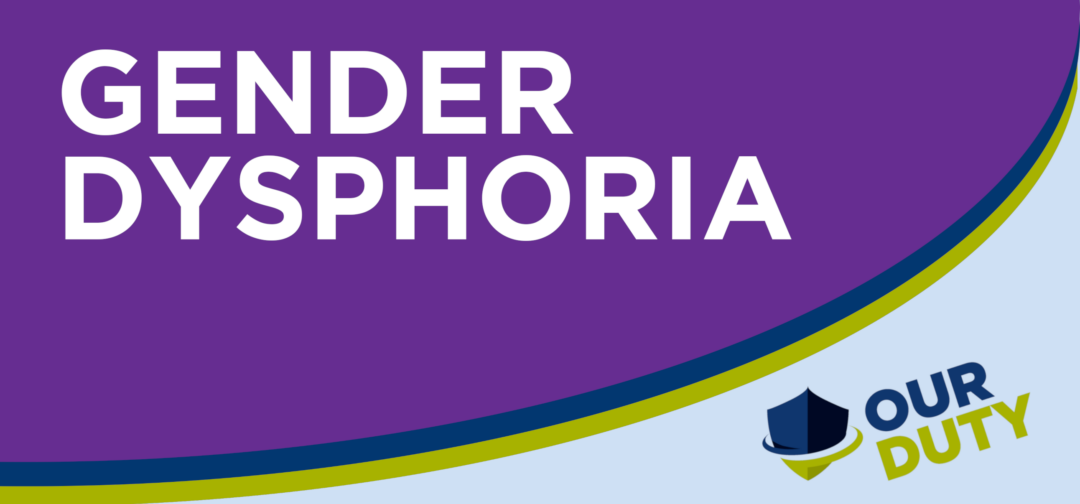Gender dysphoria is a term that describes a sense of unease that a person may have arising from excessive rumination on transgender ideation. The rumination may be brought about by anxiety or depression, and the ideation is initiated by external factors.
Gender Dysphoria is the name given by some in the medical professions as a means to pathologise feelings of unease around the sexual nature of one’s body.
An alternative name with a similar meaning is Gender Incongruence
Our Duty Definition of Gender Dysphoria
Young people who have transgender ideation are often described as having gender dysphoria. However, gender dysphoria is not a diagnosable condition. It is at best a feeling, perhaps akin to anxiety. At worst, it is merely a label those indoctrinated into transgender ideation give to their feelings (often as part of a ‘script’ they have acquired from peers, most likely online). see Fake ‘Gender Dysphoria
The DSM Definition
Gender Dysphoria is defined in the The Diagnostic and Statistical Manual of Mental Disorders frequently abbreviated to DSM. A manual published by the American Psychiatric Association.
It is believed that the introduction of gender dysphoria to the DSM was engineered by activists so as to make it easier to provide associated medical treatments, mainly wrong-sex hormones and opposite-sex imitation surgeries (none of which are ethical or clinically indicated).
The Diagnostic and Statistical Manual of Mental Disorders, Fifth Edition, Text Revision (DSM-5-TR) was published in 2022.
DSM-5 Criteria for Gender Dysphoria
| A marked incongruence between one’s experienced/expressed gender and natal gender of at least 6 months in duration, as manifested by at least two of the following: A. A marked incongruence between one’s experienced/expressed gender and primary and/or secondary sex characteristics (or in young adolescents, the anticipated secondary sex characteristics) B. A strong desire to be rid of one’s primary and/or secondary sex characteristics because of a marked incongruence with one’s experienced/expressed gender (or in young adolescents, a desire to prevent the development of the anticipated secondary sex characteristics) C. A strong desire for the primary and/or secondary sex characteristics of the other gender D. A strong desire to be of the other gender (or some alternative gender different from one’s designated gender) E. A strong desire to be treated as the other gender (or some alternative gender different from one’s designated gender) F. A strong conviction that one has the typical feelings and reactions of the other gender (or some alternative gender different from one’s designated gender) |
| The condition is associated with clinically significant distress or impairment in social, occupational, or other important areas of functioning. Specify if: A. The condition exists with a disorder of sex development. B. The condition is post-transitional, in that the individual has transitioned to full-time living in the desired gender (with or without legalization of gender change) and has undergone (or is preparing to have) at least one sex-related medical procedure or treatment regimen—namely, regular sex hormone treatment or gender reassignment surgery confirming the desired gender (e.g., penectomy, vaginoplasty in natal males; mastectomy or phalloplasty in natal females). |
Academic Discussion
A narrative review of the literature by Davy and Toze published in the peer-reviewed journal Transgender Health says:
Frequent changes of terminology, and crossover between medicalized and identity terms, appear to have contributed to conflation and confusion to the extent that GD is sometimes referred to as a specific diagnosis; sometimes as a phenomenological experience of distress; and sometimes as a personal characteristic within individuals. This frequent diverse usage of “gender dysphoria,” and the application of the concept to populations who may neither meet diagnostic criteria nor experience distress may potentially undermine the stated intention of the APA that the new diagnosis of GD would reduce pathologization.
Davy and Toze, What Is Gender Dysphoria? A Critical Systematic Narrative Review, Transgender Health, 2018

